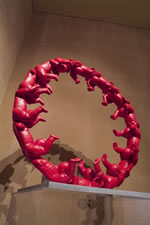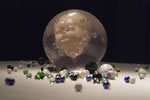 |
|
|
|
|
|
|
Mehnaz Tan
Curriculum Vitae: PDF Die drei in dieser Ausstellung gezeigten Werke der französisch-pakistanischen Künstlerin beschäftigen sich mit der Idee von Manipulation und dem Traum künstlich hergestellter Idealbilder. Sie befragen einerseits den Traum vom idealen Menschen und richten sich zugleich an die Schattenseite/Kehrseite dieses Strebens – an die möglicherweise daraus resultierenden Missgeburten, wie es ‚Mother-Nature’ beispielhaft vorführt. Wie im Wortspiel des Titels schon ersichtlich wird, spielt „Buy Chance“ mit der Frage nach vorherbestimmtem Schicksal und Elementen des Zufalls. Der Fortschritt der Bio-Technologie erlaubt uns die Kontrolle über unsere Träume und deren Verwandlung in künstliche Realitäten. Mit Werken wie „Buy Chance“ geht es Mehnaz Tan letztlich um die Frage, wie ein einziger Moment einen Traum für immer verändern kann. In ihrer Arbeit „Milk Me“ spricht die Künstlerin über das generelle Bedürfnis sofortiger Befriedigung. Angesprochen ist insbesondere das weit verbreitete Interesse an kosmetischer Chirurgie, verbunden mit der Frage, wie diese künstlichen Eingriffe die Psyche des Einzelnen und die der Gesellschaft insgesamt beeinflussen. Wann wird der Traum einer Person zum Alptraum eines Anderen?
|
 |
| Mother Nature |
With the acceleration of science and technology, especially in the fields of artificial intelligence, artificial life and the mapping of the human genome, our definition of the word identity and aesthetics has been altered in numerous ways and is constantly being challenged. One starts to probe the possibility of the commercialisation of the individual body becoming a commodity and how these fixations for new bodies no longer seem to express any tangible reality. With the body entering the arena of virtual reality and biotechnology, a vast number of discussions have arisen about the merging of the boundaries between gender and body in favour of setting up new bodies; human and non-human. Whether we like it or not, technology in one way or the other affects us all. It has become necessary to re-orient and restructure ourselves with these changes, socially and culturally.
|
Through these technological developments, the body transforms itself into an itemised product, where deformation or reformation of the prodded body, becomes a fashion mode before it is accepted as convention. Hence, a new kind of aesthetics is born. How do we place it in the context of today? How have we been made to re-situate our bodies in the post human era? Has the body become obsolete? What kind of social implications will this have? |
By meddling with the natural order of life and with the advent of genetic engineering, we are coming close to creating beings whom we can have command over. The effect that these artificial processes and man-made influences may have on future generations, by the speeding up of evolution, undoubtedly raises moral and ethical questions. These direct manipulations with our genes causes concerns about the natural cycle of life and death, and questions our natural lineage. What does this mean for the future? This throws some into the dilemma of what is acceptable and what is not “Does human genetics not inherit eugenics- if not biologically then historically? If there is a gay gene which causes homosexuality, what exactly are we to do with it? In a society structured by inequality and by no means from prejudice, such knowledge may indeed be a dangerous thing” (Kember 2003, 33). |
Through this abundance of data, are we provided with choices that can emotionally and mentally strain us and force us into otherwise non-standard conditions? By being made to comply with certain pre-natal screening procedures, are we changing the very nature of history by deciding to eliminate those that may be potentially defected, those who may be an eventual burden on society? Are we all being typecast to fit a certain category? For instance, in this particular scenario does abortion become a non-issue? |
 |
| Installation View |
What interests me is the concept of the artificially manipulated ideal which forces us to ask the question of how far we are willing to deform ourselves in order to create the ideal beauty, the ideal self. Are we very near to creating that perfect race, the perfect ageless self, or, can this process reverse itself, by creating monsters through mutation and transformation. It is worrying when there is a reversal of roles where the natural becomes unnatural and the possibility of artificiality becomes a reality. All that is left is but a trace, until even that trace element eventually evaporates. When that starts to happen, how do we begin to distinguish ourselves from others? What happens to the basis of our origin? Does normality now mean being abnormal? Are we the abnormal normal to be seen as the outsiders? |
Monsters, were once the object of display, because they were considered to be freaks of nature, mistakes that there were no explanations for, but today technology such as cosmetic surgery, allows us the chance of consciously choosing to become artificial freaks. It questions man’s own tension and conflict with himself. It reiterates the ease with which we can choose to become foreign to our own bodies. We all strive for that perfect body, but what is the criterion for being perfect? What does it take to reach perfection? Are we just living in an arrogant state of illusion? Science and technology have in the past tended to make changes that were normative and towards conventions but with the birth of genetics, the plastic formula of the body is manipulated in a way that goes beyond the standardised concept of what the body might be.
Mehnaz Tan |
| |
|
| |
|
|
|
|
|